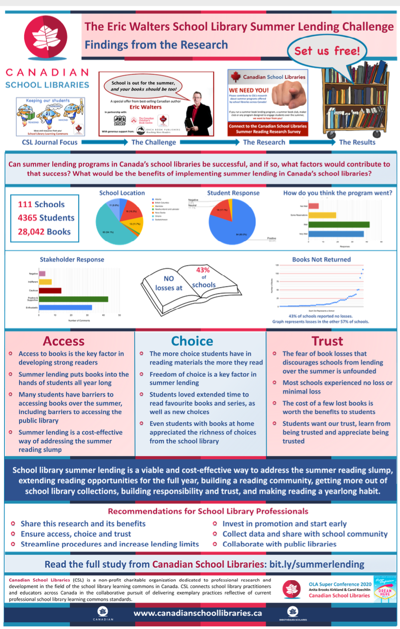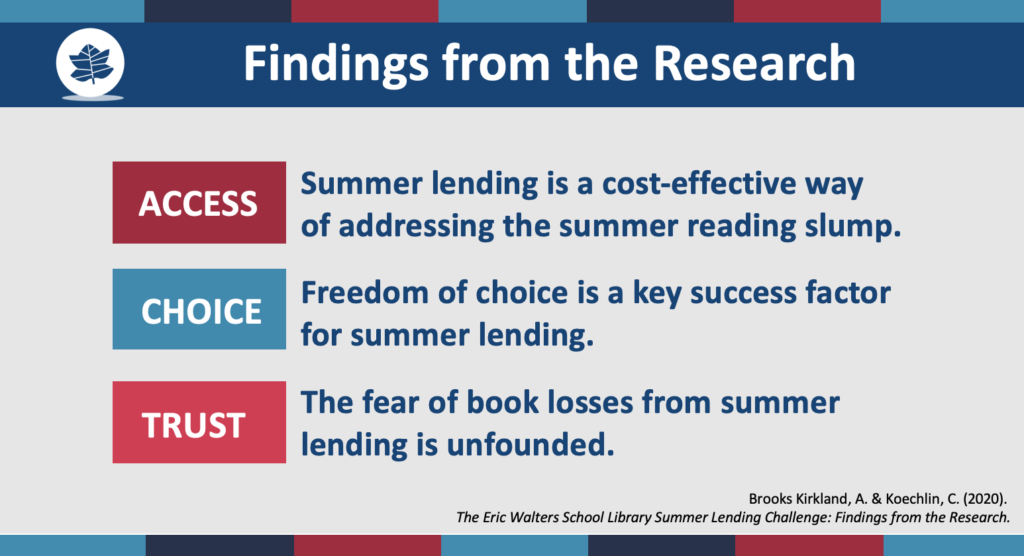
By Anita Brooks Kirkland & Carol Koechlin
Are you ready to set your books free for the summer? Goodness knows, your students need you to. Lack of access to books during the summer is a huge problem, one that public libraries do their best to address. Alas, Canada’s vast geography is one of many problems that continue to inhibit access. Yet, the most obvious solution, school library collections, remain largely sitting behind locked doors over the summer break.
School libraries in Canada have collections developed particularly to engage young readers, yet Canada’s elementary and secondary students have no access to these resources over the summer. Surely this must be addressed now, for the summer of 2022, as we emerge from more than two years of pandemic disruptions. Students have had a very hard time accessing reading materials during the school year, let alone over the summer. Summer is more desirable than ever.
“We’ve talked a lot about the equity issue here, and it’s huge. It’s huge at Annick Press and it’s huge in the world we live in. We know that a lack of access perpetuates inequality and barriers. We know that the marginalized, the economically poor are much less better off when access is impeded. And this has all been exacerbated by the pandemic – quite heavily.”
Rick Wilks, Annick Press
CSL Journal has published several articles about successful summer lending programs over the past few years, none as provocative as author Eric Walters’ challenge to school librarians, School Is Out for the Summer and Your Books Should Be, Too (2019). Walters’ call provided a wonderful opportunity for Canadian School Libraries to investigate whether summer lending programs in Canada’s school libraries could be successful, and if so, what factors would contribute to that success.

Our research, published as part of proceedings for CSL’s research symposium, TMC6 in early 2020, showed promising results, and put to rest some of the concerns about summer lending. Alas, our hopes for renewing the Eric Walters Summer Lending Challenge were dashed that year by the infamous bug. All the more reason to renew the call, so that we can look forward with optimism as we emerge from the pandemic.
Why Not Allow Summer Borrowing?
The most-cited reason for not lending books over the long summer is fear of loss. Our research found, however, that this fear is unfounded. Most schools that participated in the 2019 Eric Walters Summer Lending Challenge experienced minimal loss. Participants considered the cost of a few books as being worth the benefits to students. They observed that students want our trust, and learn from and appreciate being trusted.
So once again, almost three years later but more urgent than ever, we share the results of our research in the hope that it will convince you and your school’s administration to take action and set your books free for the summer.
The Eric Walters School Library Summer Lending Challenge: Findings from the Research
Question 1: Can summer lending programs in Canada’s school libraries be successful, and if so, what factors would contribute to that success?
Question 2: What would be the benefits of implementing summer lending in Canada’s school libraries?
Over 80% of the 111 respondents to our survey reported very positive results with summer lending through the school library learning commons. The benefits of summer reading were consistent with existing research, but also revealed some unique outcomes. While the literature does recount involvement of school libraries in some successful summer reading programs, the potential of this simple model of summer lending from school libraries had not been fully explored.
Our study provides substantial evidence that summer lending programs have a positive impact on students. One might expect that students would appreciate the opportunity to borrow books from the school library over the summer but we were pleasantly surprised by the depth of student responses.
Respondents reported on student engagement in reading, appreciation of choice and time to read books without constraints as well as gratitude for the opportunity to borrow the books for the summer and for the trust granted to them to be responsible and return books in September. These findings were replicated many times in various schools. Positive responses were noted by those leading the summer reading programs as well as by many teachers, parents and administrators.

Factors Contributing to Success
Specific themes emerged as we analyzed the survey responses.
Access: A summer lending program initiated by the professionals in the school library learning commons has proven to contribute to participation and positive results. Our research indicates that simply lending books from the existing collection will reap positive results and make good use of excellent resources without further investment. Loss of books is minimal and considerably less expensive than purchasing a few books for students to own, as is typically done in many summer reading programs. Even students with books at home appreciated having increased access. Public libraries are an important point of access, but many students remarked that they had limited access to the public library over the summer because of the challenges of just getting there. Access to books children want to read is key and the school library is a natural and inexpensive solution that is already in place.
Choice: Over and over again in the literature review previous researchers proclaimed the importance of giving students choice of personal reading materials to ensure summer reading engagement. This success factor was confirmed in our research by both students and other stakeholders. Students really appreciated the freedom to select books they wanted to read and the luxury of borrowing several books by their favourite authors or even a whole series. As expected, freedom of choice was an important factor in the success of summer lending from the school library learning commons. One special aspect to our study was the mention of having a professional on hand to guide student choices when needed.
Trust: Probably the biggest inhibitor for schools to try summer lending from the school library is the fear of book loss. Our study sheds new light on this roadblock. Responsible behaviours cannot grow without opportunity and trust. Our findings indicate that students were very appreciative of the trust they were granted to care for and return borrowed materials. This factor was repeated again and again in responses from both students and other stakeholders. This trust translated into student engagement in borrowing books, appreciation for the program, and following through with their responsibility to return books in September. The gains in building trusting relationships with students surely outweigh the minimal loss of books. This factor seems to be unique to our study and it is hoped this finding will put to rest the book loss syndrome for schools in the future.
The benefits of summer lending became clear through the research, and Canadian School Libraries can confidently make recommendations to school library professionals for continuing the success of and extending school library learning commons summer lending programs.
Benefits of implementing summer lending in Canada’s school libraries:
- Engaging students in reading to address the summer learning slump
- Building a community of readers within and across schools
- Putting books into the hands of students during the summer and all year
- Getting more out of school library collections
- Building responsibility and trust
- Making reading a yearlong habit
Realizing these benefits requires support from school administrators and teachers. Summer lending is a positive influence on placing the library learning commons at the heart of literacy and school-wide improvement.
Recommendations for school library professionals for continuing the success of and extending school library learning commons summer lending programs:
- Share this CSL summer reading research widely and discuss the potential positive impact for students in your school or school district.
- Ensure that access, choice and trust are key factors in designing your summer lending program.
- Discuss the impact that administrative procedures can have on determining the success of summer lending. Consider increasing lending limits and streamlining processes to facilitate student loans and to reduce losses.
- Invest in promotional activities to engage teachers, parents and students in participation.
- Collect school data, and analyze and share results with administration and your school community. Continue to build connections with local public libraries and collaborate on ways to engage more students in summer reading, including overcoming potential barriers to access.
Ideas to consider for extending programs to build a culture of summer reading:
- Utilize online collaboration spaces and technologies and social media for discussions and activities to get students reading, thinking and making.
- Investigate how the virtual school library learning commons can increase equitable access to quality reading materials.
- Reach out to reluctant readers and special needs learners throughout the school year and encourage them to continue connecting with books over the summer.
- Consider the needs of reluctant readers and special needs learners by providing access to appropriate texts and technologies.
We can do this! Let books fly off the shelves this summer into the hands and hearts of your students.
- When you have your summer reading initiatives in place please share via Twitter. Be sure to tag @CdnSchoolLibrar in your post!
- Make use of the ‘It’s Time to Set Your Books Free for the Summer’ badge on your virtual learning commons website and when sending out communications to your school library community.
- Read some testimonials from CSL Journal publications:
- Consider keeping track of the difference your summer reading program makes on student reading engagement and learning readiness in the fall. Analyze the results and prepare a report for your school and/or a paper sharing your findings at TMC7. Consult the CSL Research Toolkit for support.
- Take a lead on closing the summer achievement gap for your school and help students recover from the COVID reading slump.
- Keep students reading, thinking, making and learning for fun all summer!
References
Brooks Kirkland, A. & Koechlin, C. (2020). The Eric Walters School Library Summer Lending Challenge: Findings from the Research. Canadian School Libraries Research Archive. Accessed at: https://researcharchive.canadianschoollibraries.ca/2020/08/10/the-eric-walters-school-library-summer-lending-challenge-findings-from-the-research/
Brooks Kirkland, A. & Koechlin, C. (2020). The Eric Walters School Library Summer Lending Project. Canadian School Libraries Journal 4 (1). Accessed at: https://journal.canadianschoollibraries.ca/the-eric-walters-school-library-summer-lending-project/
Walters, E. (2019). School Is Out for the Summer (And your books should be too). Canadian School Libraries Journal 3(2). Accessed at: https://journal.canadianschoollibraries.ca/school-is-out-for-the-summer-and-your-books-should-be-too/
Wilks, R. (2022). Voices for School Libraries. Session proceedings from the Save School Libraries Coalition. Ontario Library Association Super Conference 2022.
Anita Brooks Kirkland and Carol Koechlin are co-editors of CSL Journal, and the researchers and authors of the study, The Eric Walters School Library Summer Lending Challenge: Findings from the Research.